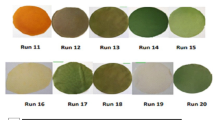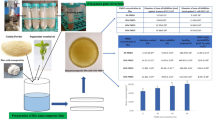Abstract
The purpose of this research was to prepare a nanocomposite film of potato starch (PS) and gum arabic (GA) containing boron oxide nanoparticles (BONs) and Anise hyssop (Agastache foeniculum) essential oil (AHEO) and investigate its structural and physicochemical characteristics. For this purpose, BONs in three levels (0, 50 and 100 mg) and AHEO in three levels (0, 100 and 200 µL) were evaluated according to the central compound design. After selecting the optimal films; an experiment to evaluate their antioxidant and antimicrobial activity was conducted. The results revealed that the antioxidant capacity and the films’ thickness increased significantly with the AHEO addition (p < 0.05). The highest antioxidant capacity was 47.62%. The results of Fourier-transform infrared (FT-IR) confirmed the formation of new chemical interactions between PS and GA containing BONs and AHEO. The X-ray diffraction (XRD) results showed that the nanocomposite films had a crystalline structure. The results of thermal analysis revealed that the increase in thermal stability of film samples indicates the proper interaction between the components of nanocomposite films. The increase in the elongation at break point of the films, contrary to their tensile strength, decreased with the increase of BONs and AHEO. Also, the results of the antimicrobial activity of the films revealed that the inhibition zone increased with the increase of BONs and AHEO. The highest inhibition zone (22.47 ± 0.96) was for E. coli. In general, the current research showed promising applications of PS and GA nanocomposite film containing BONs and AHEO for the development of active antimicrobial food packaging.






Similar content being viewed by others
References
Rasul NH et al (2022) Development of antimicrobial/antioxidant nanocomposite film based on fish skin gelatin and chickpea protein isolated containing microencapsulated Nigella sativa essential oil and copper sulfide nanoparticles for extending minced meat shelf life. Mater Res Express 9(2):025306
Bourtoom T (2008) Edible films and coatings: characteristics and properties. Int Food Res J 15(3):237–248
Sani IK et al (2023) Cold plasma technology: applications in improving edible films and food packaging. Food Packag Shelf Life 37:101087
Sani IK et al (2022) Value-added utilization of fruit and vegetable processing by-products for the manufacture of biodegradable food packaging films. Food Chem. https://doi.org/10.1016/j.foodchem.2022.134964
Chu Y et al (2020) Improvement of storage quality of strawberries by pullulan coatings incorporated with cinnamon essential oil nanoemulsion. Lwt 122:109054
Ghani S et al (2018) The preparation, characterization and in vitro application evaluation of soluble soybean polysaccharide films incorporated with cinnamon essential oil nanoemulsions. Int J Biol Macromol 112:197–202
Sani IK, Alizadeh M (2022) Isolated mung bean protein–pectin nanocomposite film containing true cardamom extract microencapsulation/CeO2 nanoparticles/graphite carbon quantum dots: investigating fluorescence, photocatalytic and antimicrobial properties. Food Packag Shelf Life 33:100912
Voss GT et al (2018) Polysaccharide-based film loaded with vitamin C and propolis: a promising device to accelerate diabetic wound healing. Int J Pharm 552(1–2):340–351
Wen P et al (2017) Encapsulation of bioactive compound in electrospun fibers and its potential application. J Agric Food Chem 65(42):9161–9179
Pirsa S, Mohtarami F, Kalantari S (2020) Preparation of biodegradable composite starch/tragacanth gum/nanoclay film and study of its physicochemical and mechanical properties. Chem Rev Lett 3(3):98–103
Pirsa S, Sani IK, Mirtalebi SS (2022) Nano-biocomposite based color sensors: investigation of structure, function, and applications in intelligent food packaging. Food Packag Shelf Life 31:100789
Dong D, Cui B (2021) Fabrication, characterization and emulsifying properties of potato starch/soy protein complexes in acidic conditions. Food Hydrocoll 115:106600
Kumar N (2019) Polysaccharide-based component and their relevance in edible film/coating: a review. Nutr Food Sci 49(5):793–823
Xu T et al (2019) Structure, physical and antioxidant properties of chitosan-gum arabic edible films incorporated with cinnamon essential oil. Int J Biol Macromol 134:230–236
Ju J et al (2019) Application of edible coating with essential oil in food preservation. Crit Rev Food Sci Nutr 59(15):2467–2480
Guo Q et al (2022) New research development on trans fatty acids in food: biological effects, analytical methods, formation mechanism, and mitigating measures. Prog Lipid Res. https://doi.org/10.1016/j.plipres.2022.101199
Omidbaigi R, Sefidkon F (2003) Essential oil composition of Agastache foeniculum cultivated in Iran. J Essent Oil Res 15(1):52–53
Zielińska S, Matkowski A (2014) Phytochemistry and bioactivity of aromatic and medicinal plants from the genus Agastache (Lamiaceae). Phytochem Rev 13:391–416
Hashemi M et al (2017) Phytochemical, antibacterial, antifungal and antioxidant properties of Agastache foeniculum essential oil. J Chem Health Risks 7(2):95–104
Pirsa S, Karimi Sani I, Khodayvandi S (2018) Design and fabrication of starch-nano clay composite films loaded with methyl orange and bromocresol green for determination of spoilage in milk package. Polym Adv Technol 29(11):2750–2758
Nguyen TP, Kim IT (2022) Boron oxide enhancing stability of MoS2 anode materials for lithium-ion batteries. Materials 15(6):2034
Wright AC (2018) The structural chemistryof B2O3 physics and chemistry of glasses-European. J Glass Sci Technol Part B 59(2):65–87
Sani IK, Pirsa S, Tağı Ş (2019) Preparation of chitosan/zinc oxide/Melissa officinalis essential oil nano-composite film and evaluation of physical, mechanical and antimicrobial properties by response surface method. Polym Test 79:106004
Meydanju N, Pirsa S, Farzi J (2022) Biodegradable film based on lemon peel powder containing xanthan gum and TiO2–Ag nanoparticles: investigation of physicochemical and antibacterial properties. Polym Test 106:107445
Sani IK et al (2021) Composite film based on potato starch/apple peel pectin/ZrO2 nanoparticles/microencapsulated Zataria multiflora essential oil; investigation of physicochemical properties and use in quail meat packaging. Food Hydrocoll 117:106719
Abdolsattari P, Rezazadeh-Bari M, Pirsa S (2022) Smart film based on polylactic acid, modified with polyaniline/ZnO/CuO: investigation of physicochemical properties and its use of intelligent packaging of orange juice. Food Bioprocess Technol 15(12):2803–2825
Karimi Sani I et al (2019) Impact of operating parameters and wall material components on the characteristics of microencapsulated Melissa officinalis essential oil. Flavour Fragr J 34(2):104–112
Shen B et al (2023) Intelligent Bio-FeS-loaded Chitosan films with H2O2 rapid response for advanced waterproof and antibacterial food packaging. Food Packag Shelf Life 37:101083
Pirsa S, Asadzadeh F, Karimi Sani I (2020) Synthesis of magnetic gluten/pectin/Fe3O4 nano-hydrogel and its use to reduce environmental pollutants from lake Urmia sediments. J Inorg Organomet Polym Mater 30:3188–3198
**ao Y et al (2023) Surface-engineered prussian blue nanozymes as artificial receptors for universal pattern recognition of metal ions and proteins. Sens Actuators B 390:134006
Pirsa S, Mahmudi M, Ehsani A (2023) Biodegradable film based on cress seed mucilage, modified with lutein, maltodextrin and alumina nanoparticles: physicochemical properties and lutein controlled release. Int J Biol Macromol 224:1588–1599
Pirsa S, Nejad FM (2017) Simultaneous analysis of some volatile compounds in food samples by array gas sensors based on polypyrrole nano-composites. Sens Rev 37(2):155–164
Wang Z et al (2020) Enhanced denitrification performance of Alcaligenes sp. TB by pd stimulating to produce membrane adaptation mechanism coupled with nanoscale zero-valent iron. Sci Total Environ 708:135063
Wang Y et al (2023) Friction behavior of biodegradable electrospun polyester nanofibrous membranes. Tribol Int 188:108891
Asdagh A et al (2021) Production and characterization of nanocomposite film based on whey protein isolated/copper oxide nanoparticles containing coconut essential oil and paprika extract. J Polym Environ 29:335–349
Lu J et al (2022) A 4arm-PEG macromolecule crosslinked chitosan hydrogels as antibacterial wound dressing. Carbohydr Polym 277:118871
Sani IK et al (2021) Thermal, mechanical, microstructural and inhibitory characteristics of sodium caseinate based bioactive films reinforced by ZnONPs/encapsulated Melissa officinalis essential oil. J Inorg Organomet Polym Mater 31:261–271
Behrestaghi FS, Bahram S, Ariaii P (2020) Physical, mechanical, and antimicrobial properties of carboxymethyl cellulose edible films activated with Artemisia Sieberi essential oil. J food Qual Hazards Control. https://doi.org/10.18502/jfqhc.7.1.2450
Oleyaei SA et al (2016) Modification of physicochemical and thermal properties of starch films by incorporation of TiO2 nanoparticles. Int J Biol Macromol 89:256–264
Ojagh SM, Vejdan A, Abdollahi M (2018) Effect of nanoclay addition on the properties of agar/fish gelatin bilayer film containing TiO2 nanoparticles. Iran Food Sci Technol Res J 14(1):27–38
Jebel FS, Almasi H (2016) Morphological, physical, antimicrobial and release properties of ZnO nanoparticles-loaded bacterial cellulose films. Carbohydr Polym 149:8–19
Malathi A, Singh A (2019) Antimicrobial activity of rice starch based film reinforced with titanium dioxide (TiO2) nanoparticles. Agric Res J. https://doi.org/10.5958/2395-146X.2019.00017.6
Deepa N et al (2007) Antioxidant constituents in some sweet pepper (Capsicum annuum L.) genotypes during maturity. LWT-Food Sci Technol 40(1):121–129
Akhlaghi H (2012) Volatile constituents from the aerial parts of Ferulago Angulata (schlecht.) boiss. growing wild northeast Iran. Anal Chem Lett 2(2):133–138
Sahraee S et al (2017) Physicochemical and antifungal properties of bio-nanocomposite film based on gelatin-chitin nanoparticles. Int J Biol Macromol 97:373–381
Zhang R, Wang X, Cheng M (2018) Preparation and characterization of potato starch film with various size of nano-SiO2. Polymers 10(10):1172
de Jara EM et al (2020) Potato starch-based films: effects of glycerol and montmorillonite nanoclay concentration. Rev Mex Ing Quím 19(2):627–637
Aburto J et al (1999) Synthesis, characterization, and biodegradability of fatty-acid esters of amylose and starch. J Appl Polym Sci 74(6):1440–1451
Avilés GR (2006) Obtención Y caracterización de un polímero biodegradable a partir del almidón de yuca. Ing Y Cienc 2(4):5–28
Song X, Zuo G, Chen F (2018) Effect of essential oil and surfactant on the physical and antimicrobial properties of corn and wheat starch films. Int J Biol Macromol 107:1302–1309
Razali MH, Ismail NA, Amin KAM (2020) Titanium dioxide nanotubes incorporated gellan gum bio-nanocomposite film for wound healing: effect of TiO2 nanotubes concentration. Int J Biol Macromol 153:1117–1135
Tang X, Alavi S, Herald TJ (2008) Barrier and mechanical properties of starch-clay nanocomposite films. Cereal Chem 85(3):433–439
Gahruie HH et al (2017) Characterization of basil seed gum-based edible films incorporated with Zataria multiflora essential oil nanoemulsion. Carbohydr Polym 166:93–103
Atarés L, Chiralt A (2016) Essential oils as additives in biodegradable films and coatings for active food packaging. Trends Food Sci Technol 48:51–62
Chen G, Liu B (2016) Cellulose sulfate based film with slow-release antimicrobial properties prepared by incorporation of mustard essential oil and β-cyclodextrin. Food Hydrocoll 55:100–107
Wang Y et al (2023) Applications of synthetic microbial consortia in biological control of mycotoxins and fungi. Curr Opin Food Sci. https://doi.org/10.1016/j.cofs.2023.101074
Gulfraz M et al (2008) Composition and antimicrobial properties of essential oil of Foeniculum vulgare. Afr J Biotechnol. https://doi.org/10.5897/AJB08.715
Khan A et al (2010) Ocimum sanctum essential oil and its active principles exert their antifungal activity by disrupting ergosterol biosynthesis and membrane integrity. Res Microbiol 161(10):816–823
Beyli PT et al (2018) Synthesis, characterization and their antimicrobial activities of boron oxide/poly (acrylic acid) nanocomposites: thermal and antimicrobial properties. Adv Mater Sci 18(1):28–36
Funding
The authors have not disclosed any funding.
Author information
Authors and Affiliations
Contributions
DH: Performed the experiments; wrote the paper. IKS: Conceived and designed the experiments; wrote the paper. SP: Contributed reagents, materials, analysis tools or data; Analyzed and interpreted the data.
Corresponding author
Ethics declarations
Conflict of interest
The authors declared no conflict of interest.
Additional information
Publisher’s Note
Springer Nature remains neutral with regard to jurisdictional claims in published maps and institutional affiliations.
Supplementary Information
Below is the link to the electronic supplementary material.
Rights and permissions
Springer Nature or its licensor (e.g. a society or other partner) holds exclusive rights to this article under a publishing agreement with the author(s) or other rightsholder(s); author self-archiving of the accepted manuscript version of this article is solely governed by the terms of such publishing agreement and applicable law.
About this article
Cite this article
Hassani, D., Sani, I.K. & Pirsa, S. Nanocomposite Film of Potato Starch and Gum Arabic Containing Boron Oxide Nanoparticles and Anise Hyssop (Agastache foeniculum) Essential Oil: Investigation of Physicochemical and Antimicrobial Properties. J Polym Environ 32, 1972–1983 (2024). https://doi.org/10.1007/s10924-023-03114-3
Accepted:
Published:
Issue Date:
DOI: https://doi.org/10.1007/s10924-023-03114-3




